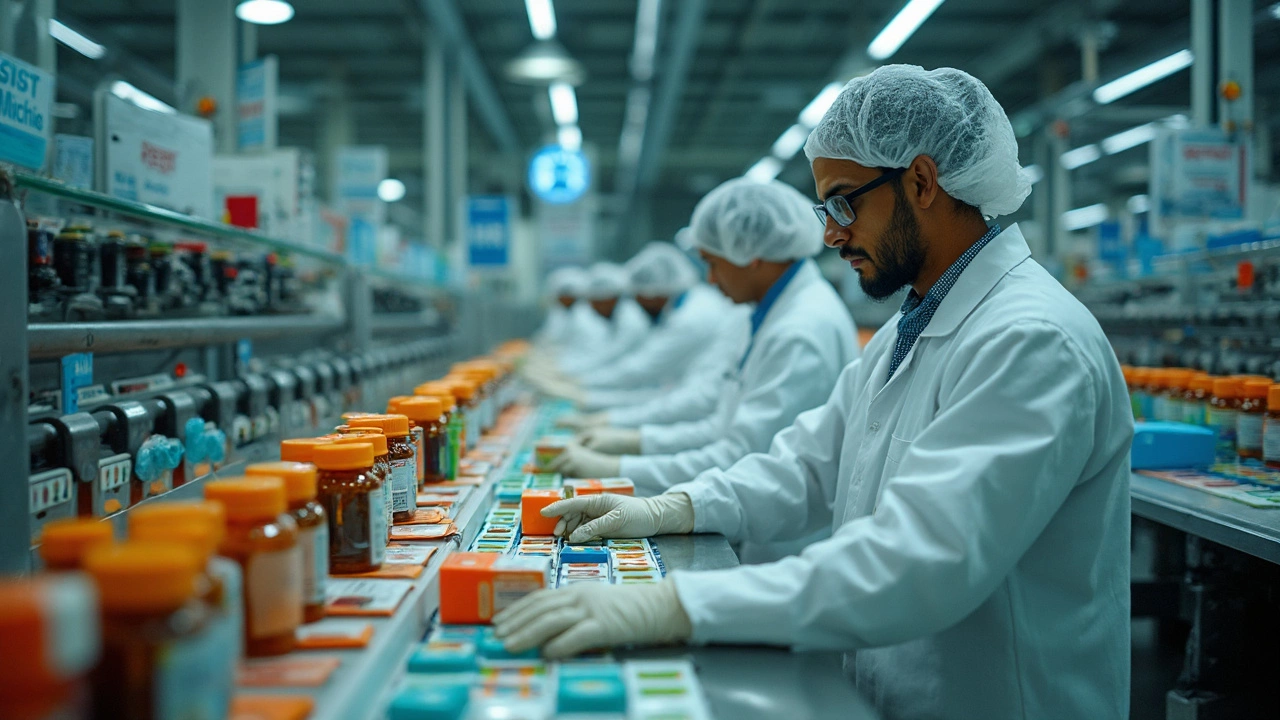Have you ever looked at your prescription bottle and wondered who actually made the medicine inside? CVS, like most big American pharmacy chains, doesn’t make drugs on its own. Instead, it gets them from a web of pharmaceutical manufacturers—many of them based halfway around the world in places like India.
It’s not just about price, although saving money is a big piece of the puzzle. India has become a global leader in making generic drugs, and CVS taps into that pool to keep shelves stocked with everything from antibiotics to blood pressure pills. A lot of the medications people pick up at CVS each day started out in massive manufacturing plants in Indian cities like Hyderabad or Mumbai.
This isn’t some back-room operation, either. We’re talking about huge companies, strict regulations, and constant quality checks. CVS works with certified suppliers who meet high standards for safety and reliability. But this global setup does raise real questions: How can you be sure your meds are safe? Why does your pharmacist trust these sources? Stick around—there are some details you’ll definitely want to know before you fill your next prescription.
- CVS’s Drug Supply Chain: The Basics
- Why Indian Pharma Manufacturers Dominate
- Quality Control and Safety Checks
- What This Means for You as a Customer
CVS’s Drug Supply Chain: The Basics
If you walk into a CVS anywhere in the U.S., you’ll find hundreds of medications neatly lined up behind the pharmacy counter. But CVS isn’t making any of these drugs itself. Instead, CVS works with a big network of suppliers to stock their stores. Many people are surprised to learn that a huge chunk of these drugs come from outside the U.S., with India playing a massive role in the pharmacy supply chain. In fact, an estimated 40% of generic medications in the U.S. are sourced directly from Indian pharmaceutical companies.
The supply chain process looks something like this: a pharma manufacturer in India (like Sun Pharma, Dr. Reddy’s, or Cipla) produces the drug, following rigorous standards. The drug is then shipped to a U.S. wholesaler—companies like McKesson, AmerisourceBergen, or Cardinal Health. CVS buys from these wholesalers, so there’s an extra layer of distribution before that pill ever reaches your hand.
Here’s a step-by-step look at how meds typically make it to your local CVS:
- Drug development and approval: Pharmaceutical companies—often in India—make generic or brand drugs and get them approved by the U.S. FDA if they’re meant for sale here.
- Bulk manufacturing: These manufacturers produce large batches of medication in certified factories under FDA oversight.
- Export and import: Approved drugs are shipped from India (or other countries) to U.S. distributors.
- Wholesale distribution: Big wholesalers store and distribute the drugs to thousands of U.S. pharmacies, including CVS.
- CVS stocking and dispensing: CVS gets its inventory from wholesalers and dispenses it to you based on your prescription.
This setup lets CVS offer a wide range of affordable drugs while sticking to U.S. health and safety rules. The emphasis on medication origins isn’t just trivia—it’s about tracking and accountability. Every bottle has batch numbers and paperwork that trace all the way back to the factory floor.
Here’s a quick look at the global reach, specifically Indian manufacturing’s impact on CVS’s U.S. shelves:
| Country | % Share of U.S. Generic Drugs |
|---|---|
| India | ~40% |
| China | ~10% |
| USA | ~40% |
| Other | ~10% |
With this system, CVS doesn’t just chase the lowest price; they’re juggling safety, reliability, and staying stocked up—all while navigating a truly global pharmacy supply chain.
Why Indian Pharma Manufacturers Dominate
So why does CVS—and so many other big names—lean heavily on Indian pharma manufacturers? It comes down to three things: cost, scale, and expertise. India isn’t just another country making pills. It's the world's largest producer of generic medicines, cranking out about 20% of the global supply. Pretty wild, right?
Most of the generic drugs you see at your local CVS are made by companies like Sun Pharma, Dr. Reddy’s Laboratories, Lupin, and Cipla. These Indian manufacturers have built a rock-solid reputation for delivering quality at a fraction of what it costs in the U.S. Their efficiency and lower operating expenses mean they can make drugs cheap—and that’s how pharmacies keep prices in check for customers.
But it’s not just about saving money. The Indian pharmaceutical sector is tightly regulated. India’s companies follow strict rules—not just from local authorities, but also from the U.S. Food and Drug Administration (FDA). In fact, many Indian factories go through full FDA inspections, just like plants in America. This is a big reason CVS trusts Indian suppliers: they deliver both value and reliability.
Check out some numbers to get a feel for why Indian pharma matters so much to the U.S. supply chain:
| India | USA | |
|---|---|---|
| Share of generics supplied to U.S. market | ~40% | N/A |
| FDA-approved plants | Over 200 | ~500 |
| Annual pharma exports | $25 Billion+ | N/A |
So, whenever you grab meds from CVS, there’s a pretty solid chance you’re using something made in India. It’s all about keeping shelves filled with safe, effective meds without blowing up your healthcare budget.

Quality Control and Safety Checks
So, how do you know the pills you grab at CVS aren’t some low-quality knockoff? The answer comes down to strict quality control and safety checks, both in the US and wherever the drugs are made—especially at those pharma manufacturers in India.
All manufacturers supplying CVS need approval from the US Food and Drug Administration (FDA). The FDA doesn’t just throw a label on a factory and hope for the best. Inspectors actually travel to India and other countries, walking manufacturing lines, looking for anything off. They test processes, ingredients, and the final product. If a plant doesn’t pass the test, it won’t be sending supplies to CVS or any US pharmacy chain.
But that’s not where it stops. CVS has its own checks, too. They work with third-party labs that randomly test batches before the meds go on the shelf. If something’s not right, the batch gets pulled, and CVS investigates fast. It’s a system designed for real accountability.
- Every batch must have a Certificate of Analysis, showing it meets safety standards.
- Temperature tracking is used on shipments—if medicines get too hot or cold in transit, they can lose their potency and must be discarded.
- Every supplier must pass regular re-audits, or they’re dropped from the CVS supply chain.
Here’s a quick peek at recent stats (2023) to show how this works in practice:
| Aspect | Number or % |
|---|---|
| FDA Inspections in India | Over 250 per year |
| Drugs recalled by CVS due to safety issues | Less than 0.3% out of total batches |
| Rejected suppliers after audit failures | More than 20 in 2023 |
If you ever wonder about your specific prescription, you can actually ask your CVS pharmacist for details about the manufacturer. They have it on file, which gives you more control and info about what you’re putting in your body. So when it comes to drug sourcing and safety, it’s a team effort—FDA, Indian manufacturers, and CVS all have skin in the game.
What This Means for You as a Customer
If you've ever wondered about the journey your prescription takes before it lands at your local CVS, you're not alone. Because CVS sources medication from large pharma manufacturers in India, there are a few things that matter to you as the person picking up that prescription.
First, let’s get this straight: India supplies around 40% of generic drugs sold in the US. According to the FDA, Indian manufacturers exported over $7 billion worth of pharmaceuticals to the States in one recent year. When you grab a generic blood pressure med or an allergy pill, there’s a decent chance it was made in India.
Your biggest concern is probably safety. The US FDA regularly inspects overseas plants and requires manufacturers to meet strict standards for quality. CVS only works with companies that have the proper certifications. Here’s a pro tip: if a recall happens, CVS is usually quick to notify patients and pull products off the shelves.
"We are committed to sourcing safe, effective medicine for our customers, wherever it’s manufactured. Compliance and transparency are mandatory for our supplier partners."
– CVS Health spokesperson (2024)
But there’s more than just trust at stake—your wallet is a huge part of the story. Generics from India can cost up to 70% less than brand-name versions. That means lower copays for you and families who rely on regular medications save a ton over time.
| Brand Name | Generic (India) | Average Cost Savings (%) |
|---|---|---|
| Lipitor | Atorvastatin | 80% |
| Glucophage | Metformin | 75% |
How can you spot where your meds come from? Usually, the pharmacy label won’t show the country of origin. If you’re curious, ask your pharmacist—they can check the manufacturer for you. You’re allowed to ask questions, and a good pharmacist won’t dodge them.
Bottom line: CVS’s global supply chain means more affordable meds and consistent supply, but you do have the right to know what you’re taking. Play it smart—double-check new medications, talk with your pharmacist, and stay informed whenever headlines mention overseas recalls.
